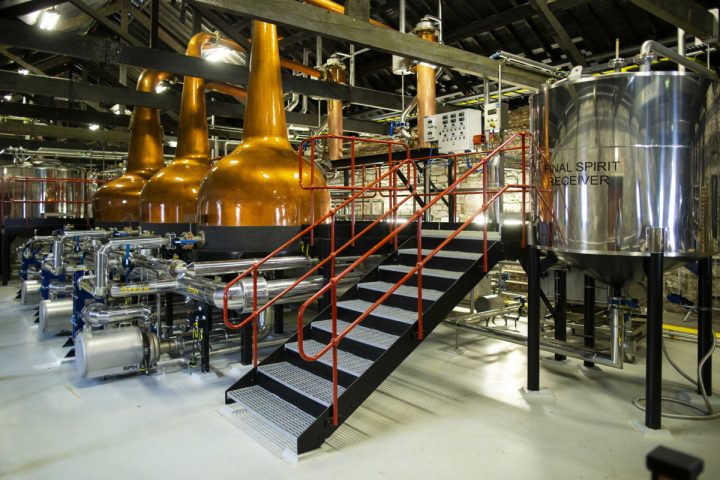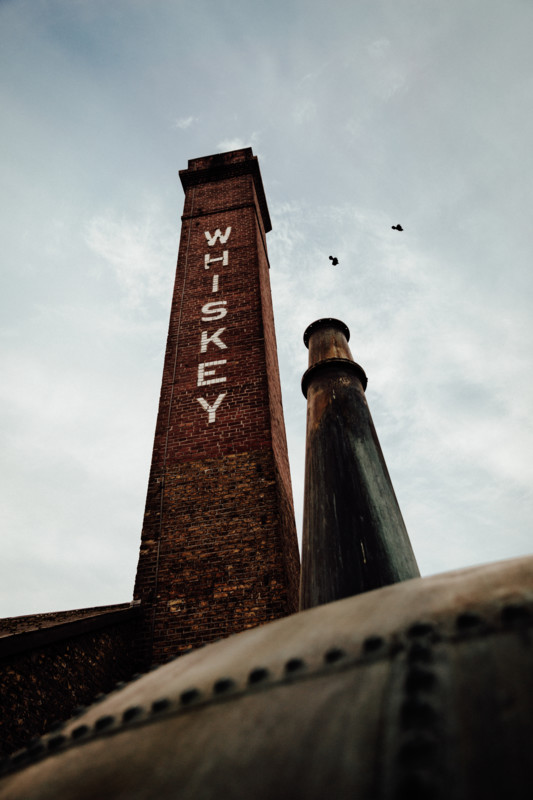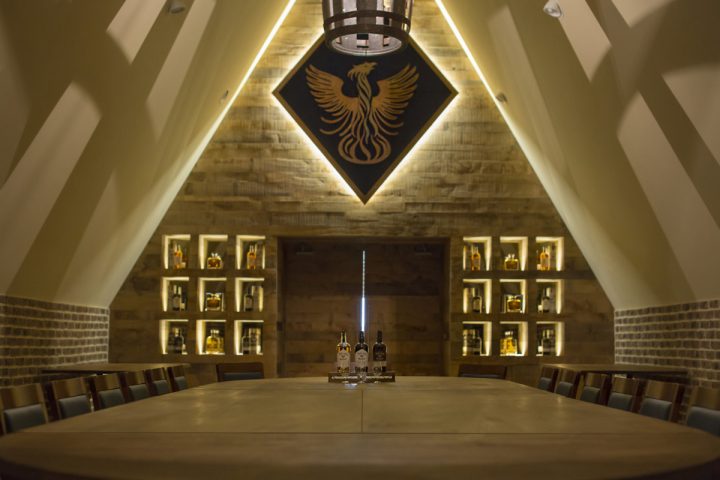
From near-extinction in the early 1980s, when it clung to a mere 1% share of the world market, Irish whiskey has been restored to prominence. Global sales have doubled during this decade, rising from 5.7 million cases in 2010 to a projected 11.5 million cases for 2019. U.S. volumes will have more than tripled in that period, from 1.38 million cases to an estimated 4.7 million cases. Perhaps most remarkably, Irish whiskey sales in the U.S. market are projected to surpass those of Scotch within the next few years, marking a major milestone in the category’s revival.
Irish whiskey sales have long been spearheaded by a handful of straightforward blended brands. Today, Ireland is rapidly building out from that platform, filling the marketplace with a broad spectrum of expressions. “Irish whiskey offers variety,” says Ryan Maloney of Westborough, Massachusetts-based Julio’s Liquors, where the category accounts for about 20% of whisk(e)y sales. “Because of its lighter taste profile, barrel finishing tends to show more prominently, creating a versatility to drink it the way you like.”
At Irish Distillers, the category’s dominant player, master distiller Brian Nation notes that Ireland’s whiskey rules encourage such versatility. “We’re fortunate in that the laws governing Irish whiskey don’t specifically require the liquid to be aged in oak—just wood,” Nation says. “That means we can try a variety of different wood types.” In addition to the traditional ex-Bourbon and Sherry, casks on offer include rum, red wine, beer, Marsala, chestnut, acacia, cherry, and pear.

Meeting The Boom
While innovation flourishes, Ireland’s producers are going full-throttle to meet the current boom. Since 2012, Irish Distillers parent company Pernod Ricard has spent €400 million ($445 million) to expand capacity at its Midleton Distillery. In 2013 the company opened the Garden Still House, an airy, glass-walled extension to the main distillery, installing three new 80,000-liter pot stills and doubling capacity. Three more pot stills were added in 2017, boosting single pot still whiskey production by 30%. Total capacity at Midleton is now at 64 million liters—more than four times that of its nearest Irish competitor, Great Northern Distillery.
Irish Distillers’ flagship brand, Jameson, saw its U.S. volume grow by 8.5% last year to nearly 3.5 million cases, taking a market share of 81%. All through the current expansion, Jameson has kept up a steady drumbeat of innovation. The brand’s latest extension is Jameson Triple Triple, a non-age statement blend matured in a combination of ex-Bourbon and Sherry barrels, as well as Malaga-seasoned casks. Triple Triple rolled out this summer in travel retail, priced at €32 ($36) a 1-liter. A U.S. launch is slated for the end of September.
Elsewhere in the Jameson quiver, Select Reserve Black Barrel ($40 a 750-ml.)—a grain whiskey matured in charred Bourbon casks and blended with 12-year-old pot still whiskey aged in ex-Bourbon and ex-Sherry casks—has hit 100,000 cases after its seventh year on the U.S. market. Black Barrel’s charred oak finish offers a robust flavor profile well-suited to mixologists, opening the door to craft cocktail bars. Jameson Caskmates ($30), a series of blends finished in craft beer barrels and appealing to the craft beer crowd, is now at 200,000 cases. Two years ago, Jameson laddered up with its Whiskey Makers Series, including Cooper’s Croze, Blender’s Dog, and Distiller’s Safe (all $70), which are now at a combined 5,600 cases.

In 2015, with its main distillery pressed to meet demand, Irish Distillers opened its Micro Distillery, an experimental space at Midleton where Nation and apprentice distiller Henry Donnelly have thus far developed 11 new whiskey styles. The Micro Distillery fills just five barrels a week, compared to 2,500 barrels a day at the main still house next door, and its three copper pot stills have the capacity to produce 50,000 liters annually. “We needed a place to do new batches,” says Donnelly. “We’ve tried rye and oats here, and tried them together. We’ve skipped distillations, and we’ve put the whiskies into a number of different casks.” The Micro Distillery laid down its first whiskies in 2016, meaning that some liquid is now old enough for release. At least one product launch has been set, but details haven’t been revealed.
The other member of Irish whiskey’s old guard, Bushmills, is doubling its production to 12 million liters, building a new distillery on its existing site that’s slated for completion by 2022. Bushmills, too, has been busy on the brand front, launching two new labels in 2017: The Sexton single malt ($28 a 750-ml.), which takes aim at cocktail consumption, and Red Bush ($23), a blend aged in ex-Bourbon barrels that targets new recruits. Last year, parent company Grupo Cuervo teamed up with MMA fighter Conor McGregor to produce and market Proper No. Twelve ($25) brand, a 40% abv blend named for the Dublin neighborhood where McGregor grew up. Proper No. Twelve has come out swinging, with depletions of 41,000 cases in its inaugural year. “It’s been our shining star of the year, with one hell of a marketing strategy,” says Mat Dinsmore, owner of Fort Collins, Colorado-based retailer Wilbur’s Total Beverage.

Transforming The Landscape
When William Grant & Sons acquired Tullamore D.E.W. from C&C Group in 2010, the brand’s liquid had long been sourced from Irish Distillers, as its original distillery in the town of Tullamore was shuttered back in 1954. Today, in perhaps the most vivid illustration of Irish whiskey’s revival, Tullamore D.E.W.’s production has returned to its ancestral home. The brand’s formidable new $100 million distillery, built on 58 acres of former bog land just outside Tullamore, was completed in 2017 and produces single pot still, malt, and grain whiskies. Capacity is 12.8 million liters, making it Ireland’s third-biggest producer behind Irish Distillers and Great Northern. Malt and pot still production began in 2014, while grain whiskey came on stream in 2017.
“The malt and pot still whiskies have now matured to the point where we can use them,” says William Grant Ireland’s planning leader, Wade McCann. “We’re in the midst of a transition, whereby a portion of own-make spirit will be going into the bottle and gradually become bigger.” The phase-out of sourced liquid should start within the next couple of years, with final determinations to be made by William Grant master blender Brian Kinsman.
Tullamore D.E.W.’s new distillery will be put to good use, as the brand has been on fire, vaulting past Bushmills into the No.-2 spot in the U.S. market. Since 2010, its global volume has more than doubled to 1.35 million cases; in the U.S., the increase has been four-fold, rising to 300,000 cases. Tullamore D.E.W. uses a variety of cask finishes, including rum and cider, to complement its Tullamore D.E.W. Original ($25 a 750-ml), and also offers 12-, 14-, and 18-year-old single malt expressions.

The seeds of Ireland’s modern distilling renaissance were planted back in 1987, when Irish entrepreneur John Teeling acquired a shuttered potato alcohol plant in County Lough, an hour north of Dublin. He remade the place into Cooley Distillery, only Ireland’s third operational distillery at the time after Midleton and Bushmills. In addition, Teeling purchased the long-shuttered Kilbeggan distillery, picking up the Kilbeggan brand, while also reviving the Tyrconnell single malt and Connemara peated whiskey brands. In 2012, he sold it all to Beam Suntory for $95 million. Under Beam Suntory’s stewardship, Kilbeggan and Tyrconnell in particular have become sought-after brands. Kilbeggan’s core blend ($25 a 750-ml.) is complemented by its Single Grain whiskey ($29) and a limited-edition Small Batch rye ($35), with the latter billed as Ireland’s highest-rye whiskey at 30% rye content. “By U.S. rules it’s technically not a rye, but the Small Batch expression is delicious—and a bargain at $35,” notes Maloney of Julio’s. Tyrconnell, meanwhile, recently released Tyrconnell 16-year-old Oloroso and Moscatel Cask Finish ($100), complementing the core Tyrconnell Original and a variety of age-statement labels finished in Port, Madeira, and Sherry barrels. While Kilbeggan Small Batch rye is produced entirely at Kilbeggan Distillery, nearly all of Beam Suntory’s Irish whiskies are made at Cooley.

Dublin’s Revival
After selling Cooley and Kilbeggan, John Teeling didn’t remain idle for long. In 2015 he opened Great Northern Distillery, converting a former Diageo brewery into the country’s largest independent distillery. With a potential capacity of about 15 million liters, Great Northern specializes in contract distilling, comparable to U.S. producer MGP. In the meantime, John’s sons, Jack and Stephen, founded their own whiskey company in 2012, and three years later opened Teeling Distillery in Dublin—the city’s first new distillery in more than 125 years. The launch kick-started Dublin’s whiskey revival: Teeling was joined by Pearse Lyons Distillery in 2017, the Dublin Liberties Distillery in 2018, and Diageo’s new Roe & Co. Distillery earlier this year.
Teeling produces about 600,000 liters and offers its core “Trinity” range, comprising the Small Batch ($40 a 750-ml.), Single Malt ($60), and Single Grain ($70) labels, with liquid for its grain whiskey supplied by Great Northern. Cask finishing has been Teeling’s signature, with the Small Batch finished in rum casks, the Single Grain in California Cabernet Sauvignon barrels, and the single malt in five different wine casks, including Sherry, Port, Madeira, White Burgundy, and Cabernet Sauvignon. These labels represent only the beginning. At present, 40% of Teeling’s production is in single malt, while 40% is in pot still, and 20% is in innovation. “We’re trying to bring new flavors into Irish whiskey,” says Teeling master distiller Alex Chasko. “For Irish whiskey to be a real category, it needs the depth and breadth of unique, unusual whiskies. We’re using such things as crystal malt, chocolate malt, crystal rye, and peated barley.”
Dublin’s newest distillery is Diageo-owned Roe & Co., which opened this past June in the old Guinness Power Station directly across street from the Guinness Brewery. Diageo reprised the name from the historic Roe & Co., which was located nearby. With three pot stills and annual capacity of 500,000 liters, Roe & Co. is now laying down spirit. While it ages, the company is offering a 45% abv blend ($33-$35 a 750-ml.) that’s currently available in Massachusetts, Connecticut, Rhode Island, New Jersey, Maryland, and Washington, D.C.

Single Pot Still’s Future
While Ireland’s growth is driven by big-volume blends, the future lies in another segment: single pot still whiskey. A traditional Irish style that faded into cult status during the downturn years, single pot still is now in the midst of a revival. The rules require it to be made with a minimum of 30% malted and 30% unmalted barley and up to 5% of other cereals, all at one distillery. The unmalted barley provides spiciness that gives single pot still its uniqueness, and its ultra-premium positioning has made it a priority for future growth.
“If you look at Ireland versus Scotland, our ultra-premium-and-above category is still fairly limited, and the category occupying that space is single pot still,” says Alex Conyngham, founder of Slane Distillery in County Meath. “Give us ten or 20 years, and single pot still will become the Irish equivalent of Scottish single malt. That’s not to say there aren’t people making great Irish single malt, but the defining, native type of Irish whiskey is pot still, which brings unmalted barley into the mashbill. This is where our future in ultra-premium lies.”
Brown-Forman acquired Slane in 2015, and has since built a new $50 million distillery on the Slane Castle estate. With a capacity of 1.2 million liters, it’s producing single malt, single pot still, and grain whiskey, filling its first barrel last year. For now, Slane offers a sourced blend ($30 a 750-ml.) that’s finished in virgin oak, ex-American whiskey, and Oloroso Sherry. “The blend doesn’t have any pot still whiskey in it—the reason being that you couldn’t for love nor money buy mature pot still,” says Conyngham. “Those that have it don’t want to sell it, because it’s too valuable in its own right.”
One player with single pot still supply is Irish Distillers. With its three new stills installed in 2017 to boost single pot capacity by 30%, the company is well-positioned to capitalize on future growth. Midleton produces seven different single pot still distillates, making it easily the segment leader. Its lineup includes the Redbreast, Spot, Powers, and Midleton ranges, and all are gaining newfound awareness.

Single pot still’s reemergence is indeed a relatively recent phenomenon. “Up until around 2010, only two single pot still whiskies were still around—Green Spot and Redbreast,” says Irish Distillers’ Nation. “There was no Powers John’s Lane or Barry Crockett Legacy. But around that time, we committed to doing additional releases of single pot still whiskies each year. It’s only thanks to my predecessor, Barry Crockett, and his father before him, who laid down stocks of single pot still whiskey, that we’re able to release today. In the 1980s, the easiest option would have been to shut the distillery for half the year and make only the blended volume required at the time. But they laid down stocks of different distillate styles and cask strengths, and that’s what gives us our range of whiskies today.”
Redbreast ($45-$250 a 750-ml.) leads Irish Distillers’ arsenal of single pot still brands; the lineup includes 12-year-old, 12-year-old Cask Strength, Lustau, 15-year-old, and 21-year-old labels. The Spot range ($51-$120) includes Green Spot (along with Green Spot Château Montelena, finished in casks from that winery); the 12-year-old Yellow Spot, relaunched in the U.S. in 2015; and Red Spot, a 15-year-old expression released in 2018 for the first time since the 1960s. The Powers single pot still range ($50-$70) includes Three Swallow, Signature Release, and John’s Lane. At the top is Midleton, whose single pot still offerings are Barry Crockett Legacy ($325) and Dair Ghaelach ($358), the latter finished in Irish oak. All these ranges combined grew by 11% to around 70,000 cases in the U.S. market last year, according to Impact Databank.
Taking a page of out Bourbon’s book, Pernod Ricard USA is also offering cask-strength batches of Redbreast to select retailers. In Massachusetts, Redbreast is working with Julio’s, Redstone Liquors, and Gordon’s Fine Wines & Liquors, while BevMo and several other retailers have signed on in California. Each batch is a barrel equal to 200-250 bottles, with the bottles retail-priced at $100 a 750-ml. “There will be a fluctuation between percentages of Bourbon casks and Sherry butts in the batches, so each will be slightly different from the other,” notes Alex Thibault, brand ambassador for luxury whiskies at Pernod Ricard USA.
Teeling is also in the single pot picture, having released its Teeling Pot Still label last November. It’s currently sold in Ireland, travel retail, and European markets, with a U.S. launch slated before the end of this year. The 46% abv expression, made from a mashbill of 50% malted and 50% unmalted barley, is aged for three years in ex-Muscat barrels. The retail price will be $65, with just 1,000 6-bottle cases in the first U.S. release. “It’s the first single pot still whiskey from Dublin in over 40 years,” notes Jack Teeling. “We’ve been trying to highlight the return of single pot still whiskey to its historic home.”
Elsewhere, Glendalough Distillery has a pot still expression ($50-$60 a 750-ml.) that’s slated for a U.S. release this fall. Contract-produced by West Cork Distillery, and aged in first-fill Bourbon casks for just over three years, the whiskey is then finished for six months in virgin Irish oak harvested from managed forests near Glendalough’s distillery in County Wicklow. “Each bottle will have a tree number, cask number, batch number, and bottle number,” notes Glendalough founder Gary McLoughlin.

Education’s Importance
Irish whiskey has returned to glory, but there’s still work to do on educating consumers on all its nuances and styles. The Irish whiskey section at retail stores is often a blur, offering little clarity. “There isn’t a lot of delineation yet,” says Maloney of Julio’s Liquors. “People are trying these products without any preconceived notions, but more education will be required. If you innovate, you have to educate—there’s no way around it.”
At Chicago area retailer Binny’s, spirits buyer Brett Pontoni notes that currently most education and consumer engagement is done by the big brands. “Single pot still, for example, still needs to define itself as the quintessential Irish style,” he says, citing Redbreast, the Spots, and Writers’ Tears as his top single pot still labels. “The larger brands want to be represented together, so the story gets told within their brand portfolios, rather than by type.”
Nonetheless, retailers agree that Irish whiskey should seize the moment. “There’s a huge opportunity to educate people about its different experiences,” says Annette Alvarez-Peters, who leads the beverage alcohol team at Costco. “Consumers want to explore and discover, and Irish whiskey offers that sense of place they’re searching for.”
Dinsmore of Wilbur’s agrees, and foresees a bright future ahead. “Irish whiskey is still at a relatively young stage in its development, so it’s true that there’s not much segmentation on the shelf,” he says. “In some ways, it’s where Scotch was 30 years ago. But the opportunities to tell the category’s story are limitless.”